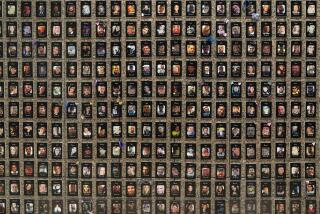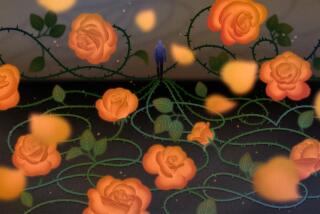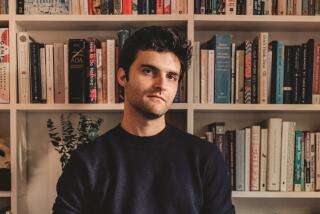Old Enough to Grieve : Children With Violence in Their Pasts Learn to Cope With Death
Mark slouches in a grown-ups’ chair, his feet dangling, his 6-year-old face solemn. He has just finished a doughnut and is telling the others in the room how his Dad was killed--”He got hit on a motorcycle, without a helmet.” Mark sucks his thumb for a moment, then, expressionless, adds, “It was sad.”
He is the youngest member of a peer bereavement group at Hathaway Children’s Services in Pacoima, a private nonprofit agency serving severely emotionally disturbed children ages 5-18.
Once a week, for an hour, eight of these youngsters, most of whom call Hathaway home for now, sit around a small room with counselors and talk about the deaths of people they loved.
For the most part, they are dealing with violent deaths. Shooting deaths. Deaths from drug overdoses. Suicides.
Death is not the only trauma in the young lives of these youngsters, whom social workers call “multiproblem” children. Their home lives have been filled with physical and sexual abuse, multiple foster homes, failed adoptions, instability.
The bereavement group is one way one agency is trying to meet the needs of a society in which adolescents and preadolescents now deal with such realities as drug-dependent parents and gang murders of peers.
Fifteen-year-old Eric says: “I’m here, because, when I was 14 months old, my mother committed suicide with a sleeping agent.” He describes an abusive early childhood in the care of his father, until, at age 4, he went to live with his grandmother. Since then, Eric adds, his voice without emotion, he has been in and out of placements.
When he was eight, he says, “I started to freak out.” A Hathaway resident for 2 1/2 years, he is trying to deal with “rejection and all that kind of stuff.”
It was Eric who suggested the need for this group, started 16 months ago by therapist Pamela Davis, of the Hathaway staff, and Stephen Lott, a psychology intern. Davis, as a former medical social worker, was experienced in dealing with death and grief.
In the bereavement group, Davis says, the youngsters (all of whose names have been changed in this story to protect their privacy) find “a place where they have friends they can talk to about losing a person they’ve been real close to. They know how to offer each other support.”
Six-year-old Mark, who lives at Hathaway, joined in October, a month after his father was killed. Usually, he stays for only 30 minutes each time, which counselors feel is all he can handle.
At a recent session, with prompting from group leaders, he talked about death and cemeteries. Then he wiggled out of his chair, and, on all fours, began chasing a moth. Later, he climbed onto a sofa next to Eric and silently linked one arm through the older boy’s.
Laura, a worldly wise 13-year-old who was concentrating on applying her lip gloss, thinks Mark is doing well. “Sometimes little kids can’t handle some of the things here,” she says, adding, “I just fiddle with my fingers” if things get bad.
But, prompted, she talks openly about her loss--the death from cancer of the beloved aunt with whom she lived.
She talks, too, about an abusive mother who treated her like “a big maid around the house. If I’d quit, she’d spank me with a big 4-by-4 board. My life was really hard.”
Laura lived at Hathaway, off and on, for seven years, from the time she was age 7; now she lives in the Valley with her father but attends school at Hathaway.
Does she see her mother?
Laura smiles, and says, “If I did, I’d run.”
She is in transition. She has taken the first step in breaking away from Hathaway but is not ready for total integration into the mainstream, for public school.
Michelle, 12, another member of the group, is wearing a “Don’t worry. Be Happy” T-shirt. And she is explaining that her mother died in August--”She got hit by a car” while walking down the street. (The driver was on drugs).
What she does not say is that she had been removed from her mother’s home, an abusive situation, at age 4 months, that her father is also dead. Michelle has lived at Hathaway for four years.
Later, in an interview, Davis explains that with these children “there is still a fantasy that I’ll get back together with my mother and things eventually will end up OK.”
Such fantasies are part of the glue that bonds them to one another.
Mark, for example, talks about having seen his father killed. But, Davis says, “He did not see it. He’ll describe it to you as though he had seen it. Maybe he feels he would be a little closer to him if he had seen it.”
As they share, the youngsters start to see reality. Linda Librizzi, assistant director of clinical services who is sitting in on this session with two interns while Davis is on maternity leave, describes that truth--that “life was hell” for all of them even before this awful thing happened.
Sometimes the group plays games like “three wishes.” This day, Laura’s wishes are “that my aunt took care of herself and went to the doctor, that my real grandmother is not dead any more . . . and that I’d get rich.”
Eric’s first wish is that “wherever my mom is, for her to take care of her problems and not be a fool.” His second is “to have a better family,” instead of the one he has, all of whom, he says, have “long hair and beards and stuff. My grandma has a beard.”
The group titters at this revelation.
Well, Eric says, she does have a lot of chin hairs.
His third wish: “To make it through college.”
He talks about being an orthopedic surgeon, then adds, “but I’ve thought of being a mortician.” There is a strange silence. Eric smiles and says, “That was just a cruel joke.”
All he wants, Mark says, is “for my father to be alive.”
But he’s dead and, Mark adds, “It’s hard.”
Andrew, 14, who has been silent, wishes only “to go home.” Later, a counselor says that “like many others here, there have been suicides in his family, a long history of more than one.”
As therapy, members of the group have written poems, which have been mimeographed and stapled into a little booklet called, “I Love You, Thank you, Good-Bye.”
These are not love poems in any traditional sense.
One child wrote:
You killed my sister,
And screwed up my life
And hurt my family. ...
Mark wrote:
You did a stupid thing. You shouldn’t
Have gone so fast on that motorcycle.
You knew it was dangerous.
You should have worn a helmet or something
To protect your head. ...
His poem concludes:
You really hurt me and a lot
Of other people.
One contribution is a “Dear Mom” letter to a dead mother from a runaway daughter. It asks, “So how do you like life up there, or down there? . . . I know I’ve hurt you and you hurt me, but when we meet again I hope our lives will be 100% better. . . . I am sad ‘cause I never got to say I love you. . . . “
Early on, each youngster was asked to draw a picture of the person who had died, as a way of introducing that person.
Davis remembers a picture drawn by one 12-year-old: “There were more drugs in that picture, things I’d never heard of. He was able to really share a lot of anger about his mother using drugs,” his fury at the boyfriend who got her hooked. The mother had died of an apparent overdose.
Asked to depict what happens to a person after they die, one child painted his paper totally black, with “blood” dripping down; another, a youngster who tended to deny feelings, drew a big sun with flowers, all bright and yellow and pretty.
On average, a child stays 11 months in the group. Some can’t handle it and drop out. Others cling to it. Everyone also receives one-on-one psychotherapy twice a week.
Larry Brooks, a Hathaway staff psychologist, speaks of the “tremendous value” of this group of peers in dealing with loss: “The worst thing in the world one can do . . . is keep it to themselves. It just festers.” Alone, he says, youngsters can become detached from reality, which creates fertile ground for “the seeds for feelings of hatred and cruelty.”
“Violence tends to replicate itself,” Brooks says. “When kids have been exposed to violence, you see it in the violence they enact.” He adds, “Anyone who has experienced a murder, that in itself decreases the preciousness of life and increases the possibility that the person himself could be capable of murdering.”
And, Brooks says, a child exposed to life-threatening circumstances and the attendant chronic fear may, as an adult, “turn the tables. They put other people in the circumstances they were in. It devalues life.”
Some in the group have had scrapes with the law--perhaps arrests for theft or drugs. And, Davis says, “there have been times when kids have been suicidal,” overwhelmed by guilt feelings about a parent’s death or wanting to join that person in death.
No one is forced to attend, but they are strongly encouraged. Of course, Davis says, a child may sabotage the effort by refusing to be an active participant. But even then, she says, it is helpful for that kid to see that others are “not embarrassed to share how sad they feel, that it’s OK to talk about it.”
At home, she says, “it’s not really OK for them to talk with their mother about the father that has died.” It is difficult to express anger at a dead parent with whom one had had a troubled relationship. But these children are angry. Angry that a mother or father was not there for a birthday, for Christmas. A girl who lost her mother on her birthday wondered whether it was OK for her to celebrate birthdays.
Like Eric, an engaging youngster with a curly ponytail and an earring in his left ear, many have gone from abusive homes into foster homes or group homes, where they would act out, and finally to Hathaway. There, Brooks says, they find “a safe place that isn’t going to hurt them back.”
Hathaway was founded as “Kiddie Koop,” an orphanage, in 1919. Today it’s situated on an idyllic 300 acres in Angeles National Forest--once Cecil B. DeMille’s ranch and a gift from the DeMille family. It houses 126 children, who may attend an on-site accredited school through 12th grade.
Eric has, through therapy, come to realize that it was not his fault that his mother killed herself, that it was “her problems.” At 15, he has known tragedy enough for a lifetime: His aunt was shot and killed the year before his mother’s suicide. His mother was pregnant when she killed herself.
He describes his father, a Vietnam veteran almost legally deaf from mortar shelling, as “wild and he smokes marijuana. I try to keep my home visits to a minimum.”
Sometimes, he says, his Dad grows morose and “he cries and talks to me about Mom, about Vietnam. He showed me a bracelet that belonged to my mom.”
At a recent group session, Laura listened to this and suggested, “If I were your father, I’d bury the jewelry.”
Last Veterans’ Day, Eric, with his Dad, visited his mother’s grave at Forest Lawn. The traveling replica of the Vietnam Veterans Memorial, the black granite wall, was also there that day.
“That,” Eric says, “was heavy duty.”
He wants to be a surgeon. Michelle wants to be a teacher. Laura wants to be a lawyer, working with troubled kids.
But, in reality, what are their chances? Some Hathaway youngsters will make it, Librizzi says--”There are some resources out there for kids who have been part of the system,” money for education.
According to Hathaway statistics, 68% of the youngsters--who are referred by agencies including the Los Angeles County Department of Children’s Services and the Probation Department--will improve enough to return to their own home, a foster or adoptive home, a group home or a less intensive institution. The average residential stay at Hathaway is 18 months.
The bereavement group is special, Librizzi says, in that “death is what binds them together.”
In group, Librizzi asks Mark, the youngest member, “If there’s a little boy or girl who lives at home and their Mom or Dad dies, what do you think they should do?”
Mark removes his thumb from his mouth and says he thinks they should talk to other family members. His 4-year-old brother, he adds, “asks me a lot of questions.”
More to Read
Sign up for Essential California
The most important California stories and recommendations in your inbox every morning.
You may occasionally receive promotional content from the Los Angeles Times.










